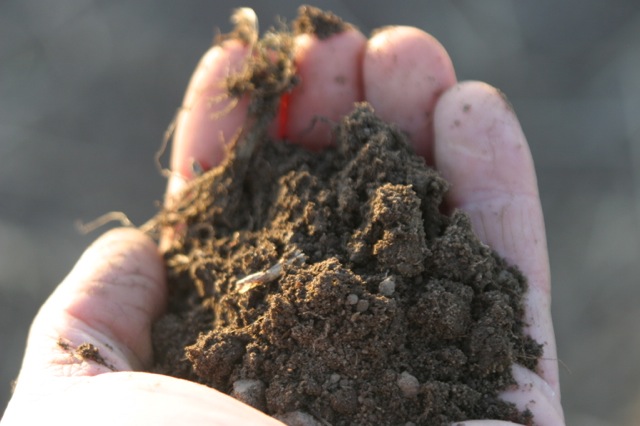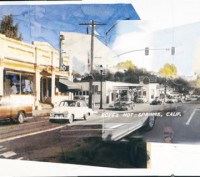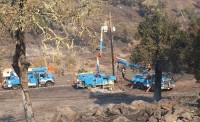(By Stephanie Hiller) — Progress on climate change has been painfully, frighteningly slow, and as a result we are already grappling with its effects. But COP21, held last December in Paris, proposed new levels of consensus among the nations of the world. One noteworthy accomplishment was the French initiative to reduce greenhouse gases by putting the carbon back in the soil. The Four Per Thousand Initiative states that increasing soil carbon by .4 percent if practiced worldwide could actually reduce greenhouse gases by 75 percent.
This idea is not new to organic farmers already practicing what is now being called “regenerative agriculture,” a method that emphasizes the importance of rich healthy soils. Here’s how it applies to climate change. Through photosynthesis, plants naturally sequester carbon from the carbon dioxide in atmosphere. Some of this carbon is used for the production of carbohydrates; the rest is deposited in the roots of the plant where it nourishes billions of microscopic fungi and bacteria. Leftover carbon is put back into the soil. If soil is always kept planted and no chemicals are introduced, these micro-organisms build up fiber and carbon within the soil. (Bare ground oxidizes the carbon and sends it back into the atmosphere.)
The result is rich humus that supplies plants with nutrients without the need for added fertilizers, holds water more efficiently, and retains more carbon.
Tilling the soil with tractors or even by hand breaks up the roots and destroys many of the tiny organisms. Allowing ruminant animals like cattle and sheep to graze at will also destroys the rich soil culture. New grazing methods, which actually mimic the behavior of wild herding animals on natural open prairies, do not allow the herds to chow down on one small area, stripping it of all its nutrients. Together these methods produce a rich, fertile soil, loaded with organic material – carbon.
“It’s all about letting the soil do the work for you,” said Seth Dolinsky who works as a consultant to growers in the Sonoma Valley, many of them vineyards “interested in diversifying their property, bringing in wild cover crops like vetch and lupines and creating hedgerows for birds and insects.
“A big part of regenerative agriculture,” he added, “is providing places for other species.”
On stage at the Heirloom Seed Festival last August, tall in his cowboy boots and hat, Paul Kaiser looms large over his audience as he explains how he farms three acres in Sebastopol with his wife Elizabeth and a crew of four to eight full-time employees without tilling the soil and or adding amendments, even organic ones, except the compost they make on their own. Their farm is well known throughout the county for its extraordinary success. Selling at farmers’ markets and through its Community Supported Agriculture (CSA), the farm grosses $100,000 per acre. Paying its workers a living wage, it nets $30,000 an acre, more than an average winery!
I visited the farm on a drizzly day in December and was greeted by Elizabeth Kaiser. Even in late fall, the beds are packed with leafy greens, cauliflower, cabbage and the last of the harvest vegetables, reflecting one of the Farm’s three principles: First, keep living plants in the soil at all times; new starts are installed within 24 hours after a bed is harvested.
The second principle is, Disturb the soil as little as possible. The plants to be harvested are cut, not pulled, leaving the roots in the soil to decompose. The Kaisers are pioneers in no-till farming, providing a successful model that others are starting to emulate.
“A large percentage of the greenhouse gases from agriculture is through tillage,” she explains. “Tillage opens up and breaks down aggregates, and carbon comes in contact with oxygen, forming nitrous oxide and carbon dioxide gases. Dr. Rattan Lal, an expert in soil management, says two thirds of our planetary soil carbon is released through poor soil management, mostly tillage. Before tillage, soil organic matter (SOM) in ag lands was six to ten percent; now in California we have one percent.” In their six years of farming, the SOM at their farm has gone from 2.4 percent to ten percent, Elizabeth noted. As a result, water use has declined; the soil holds water so efficiently that the Kaisers only need to run their drip system twice a week for 20 minutes.
Finally, they practice agroecology, creating environments with hedgerows providing habitat where natural predators keep the pest population under control and working with nature, instead of against. The Kaisers produce five to seven harvests a year, compared to the one or two harvests of the typical farm. “It’s very intensive,” she said. But profitable.
“Most of the work we do on our farm has to do with hauling feed for the animals,” said Rebecca Black, showing me buckets of sparged barley, a waste product that they truck from local breweries to feed their heirloom pigs, who feast as well on waste produce from Olivers’ Market and dairy products from local farms. Because of their excellent diets, which include no grain whatsoever, they produce very little gas and there is no offensive smell in their paddocks. Handsome animals averaging around 600 pounds each, they are bred for their parenting skills. Their offspring are butchered and the meat sold in local markets.
Black and her husband Roy Smith practice “management intensive grazing” of their pigs and sheep on their ten-acre farm. The animals are moved from one portable paddock to another so that the land is not impacted by overgrazing. Instead, the animals help work the soil while they graze, leaving behind the helpful nutrients from their urine and excrement.
What about methane?
Roy explains that methane is released by a water-borne bacteria found in the guts of ruminant animals to break down roughage. Termites also release methane by the same process, he said, but what is really causing methane pollution is the use of ponds and lagoons on animal farms where the same water-borne bacteria working on the undigested grains in animal excrement to release the toxic methane. In the ecological setting, writes Jack Kittredge of the Northeast Organic Farming Association, other bacteria will actually consume methane.
Up on the hill in a grove of eucalyptus trees, the pig family’s boar is tromping on fallen leaves, increasing the soil’s organic material with each step. A handful of chickens run about nearby. Roy explains that they roam the property, devour insects, and reproduce in the spring, providing a steady supply of poultry meat to their human family at no cost. I wonder about raccoons but forget to ask.
Roy and Rebecca can hardly contain the immense stream of knowledge they have accumulated about raising animals for food. It’s obvious that they love what they do, even on this cold blustery winter day. They are proud that they have achieved their first goal. “We are self-sufficient in feed, and we can supply protein for 30 families without purchasing inputs.”
Does that mean this is a profitable operation? Not really. The couple works hard to create a model of the kind of animal husbandry they believe is healthy for animals and people as well as good for the environment. On another property they are working to build a “farmstay” where guests can spend a weekend learning about these farming methods.
“The eco-logic works,” said Roy, “but the economics is a problem.”
What would improve that situation? The government could reduce its subsidies to large grain producers and subsidize small farms, said Rebecca. Waste from grocery stores could be delivered to farms so that farmers and ranchers do not have to pay the costs of transporting it. That is already required in Burlington, in Vermont, said Roy, the most advanced state in the country in its support of these farming methods.
“We are really behind other countries. In France, legislation outlaws the dumping of waste by grocery stores. England has all kinds of plans that favor small farms. They don’t provide subsidies to farms.”
According to Torri Estrada of the nonprofit Marin Carbon Project (MCP), funding is now becoming available through the regional offices of the Natural Resources Conservation Service (NRCS) since Governor Brown’s “Healthy Soils” protocol was announced last February.
The MCP has been working with local ranchers like well-known Strauss Creamery to transform soil productivity by adding one-half inch of compost to the soil and practicing managed grazing. MCP’s research with the University of California showing the efficacy of their methods influenced Governor Brown last February to add a “healthy soils” pillar to his plan for the state’s agricultural response to climate change.
The research made it possible to influence policy, Estrada explained, and now government funding will help remove a primary barrier to farmers, that of cost. It costs about $500 an acre to supply the compost.
There are other barriers. “Farmers are basically conservative. Agriculture has not been willing to come to the climate table. The predominant story from climate activists and environmentalists is that ag is all bad.” So MCP works at building trust between sectors.
Its approach is not “exclusively organic,” making it easier for conventional farmers to join the carbon process. But allowing farmers to use fertilizers and pesticides will change the carbon equation. Pesticides kill microorganisms in the soil and adding fertilizers also depletes soil organic matter, resulting in carbon losses.
Like all major changes, the move to carbon farming will face some resistance. But the processes are natural and simple, “because we are working with nature instead of against her,” notes a cattle rancher in the Midwest utilizing, probably without knowing it, the language and basic principle of a hitherto obscure method of farming called permaculture.
Organic farmers have known for decades that the secret of successful farming lies in the soil.
Now the wisdom of carbon farming as a response to climate change has spread from small organic farms to policy makers worldwide, and it is growing. It has to. Climate change is the most overwhelming and terrifying catastrophe we have ever had to face. But now that the cat is out of the bag, the fossil fuel industry will face increased pressure to change. Meanwhile, putting that carbon back into the soil will go a long way toward protecting our food supply in the challenging years ahead.
A note about sustainable fishing.






One Comment